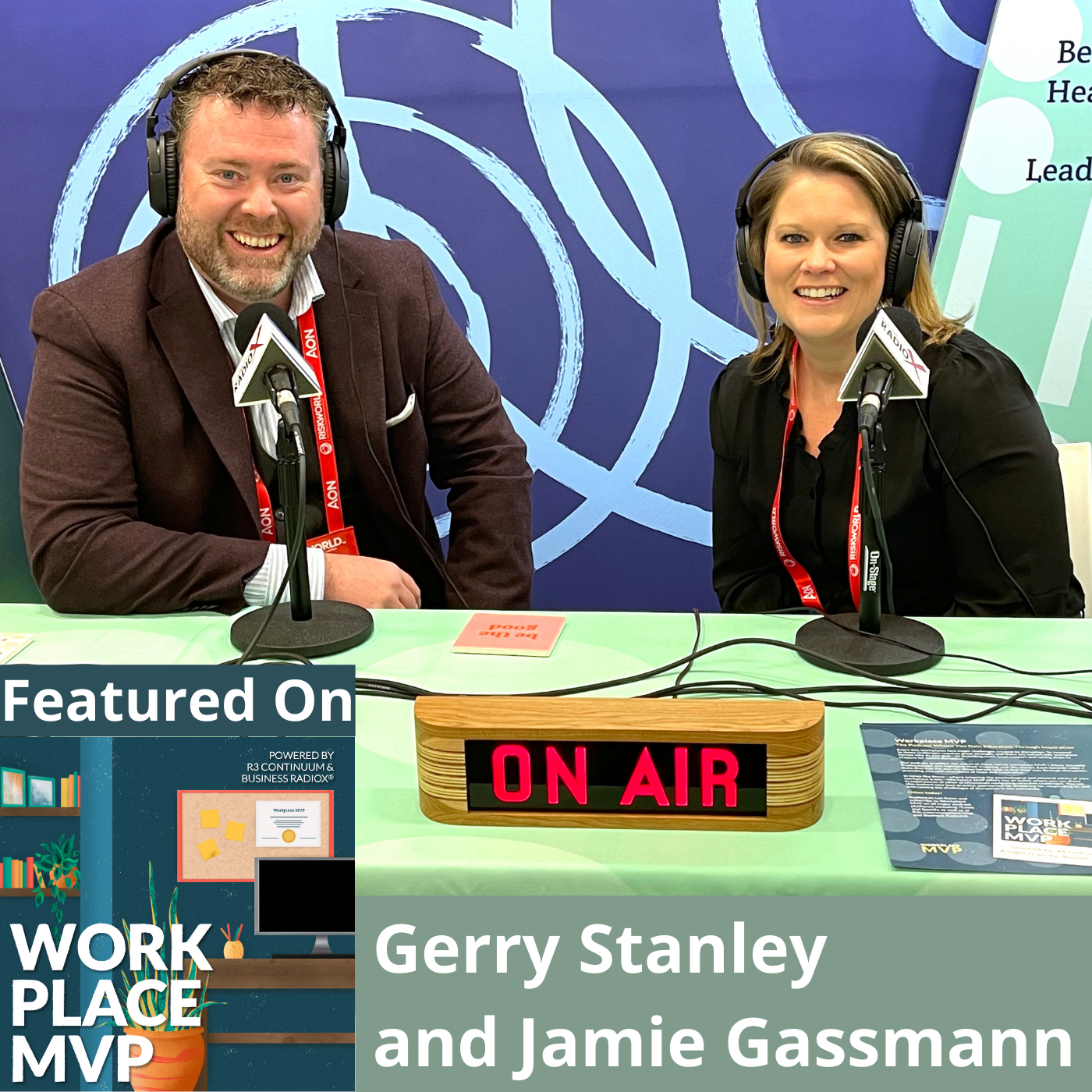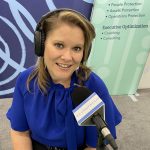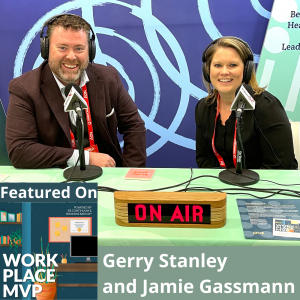
LIVE from RISKWORLD 2022: Gerry Stanley and Mark Moore, Harvard MedTech, LLC
Gerry Stanley and Mark Moore with Harvard MedTech spoke with host Jamie Gassmann LIVE from RISKWORLD 2022 about their mission and the technology developed by Harvard MedTech. Their innovation involves virtual reality headsets combined with behavioral health interventions which assist claimants in dealing with workplace trauma. Gerry and Mark talked with Jamie about the specifics of how this technology works, the types of claimants that can benefit from the approach, its use in pain management, and more.
Workplace MVP is underwritten and presented by R3 Continuum and produced by the Minneapolis-St.Paul Studio of Business RadioX®.
This show was originally broadcast from the RIMS 2022 RISKWORLD Conference held at the Moscone Center in San Francisco, California.
Gerry Stanley is Senior Vice President and Chief Medical Officer, and Mark Moore is Senior Vice President, Market Partnerships, for Harvard MedTech, LLC
Harvard MedTech is committed to Smart Device Technology for in-home patient care. Its mission is to push the frontier of capabilities and create or find the most innovative smart technologies from around the world. These technologies may be devices, systems, or elements that expand an extraordinary human experience.
They are also committed to home-based therapies to facilitate greater compliance by – and a higher quality experience for – the patient. Their dedicated behavioral health clinicians train patients on how to use smart equipment and technologies, and provide oversight, motivation and encouragement.
What most makes HMT stand apart is our unmatched ability to integrate technology with behavioral science in a way that produces faster, safer and better outcomes for patients, increased convenience for providers, and lower costs for payers.
Company website | Linkedin | Gerry LinkedIn | Mark LinkedIn
About Workplace MVP
Every day, around the world, organizations of all sizes face disruptive events and situations. Within those workplaces are everyday heroes in human resources, risk management, security, business continuity, and the C-suite. They don’t call themselves heroes though. On the contrary, they simply show up every day, laboring for the well-being of employees in their care, readying the workplace for and planning responses to disruption. This show, Workplace MVP, confers on these heroes the designation they deserve, Workplace MVP (Most Valuable Professionals), and gives them the forum to tell their story. As you hear their experiences, you will learn first-hand, real-life approaches to readying the workplace, responses to crisis situations, and overcoming challenges of disruption. Visit our show archive here.
Workplace MVP Host Jamie Gassmann

In addition to serving as the host to the Workplace MVP podcast, Jamie Gassmann is the Director of Marketing at R3 Continuum (R3c). Collectively, she has more than fourteen years of marketing experience. Across her tenure, she has experience working in and with various industries including banking, real estate, retail, crisis management, insurance, business continuity, and more. She holds a Bachelor of Science Degree in Mass Communications with special interest in Advertising and Public Relations and a Master of Business Administration from Paseka School of Business, Minnesota State University.
R3 Continuum
R3 Continuum is a global leader in workplace behavioral health and security solutions. R3c helps ensure the psychological and physical safety of organizations and their people in today’s ever-changing and often unpredictable world. Through their continuum of tailored solutions, including evaluations, crisis response, executive optimization, protective services, and more, they help organizations maintain and cultivate a workplace of wellbeing so that their people can thrive. Learn more about R3c at www.r3c.com.
Company website | LinkedIn | Facebook | Twitter
TRANSCRIPT
Intro: [00:00:02] Broadcasting Live from RISKWORLD 2022 at the Moscone Center in San Francisco, it’s time for Workplace MVP. Brought to you by R3 Continuum, a global leader in helping workplaces thrive during disruptive times. Now, here’s your host.
Jamie Gassmann: [00:00:21] Hey, everyone. Your host, Jamie Gassmann here. And I’m broadcasting from RISKWORLD 2022 in the expo hall and our show sponsor’s booth, R3 Continuum. And joining me is Gerry Stanley and Mark Moore from Harvard MedTech. Welcome, gentlemen.
Gerry Stanley: [00:00:38] Hey, thanks for having us.
Mark Moore: [00:00:39] Thanks for having us.
Jamie Gassmann: [00:00:40] Yeah. So, tell me a little bit about what Harvard MedTech does.
Mark Moore: [00:00:45] Gerry’s got this.
Gerry Stanley: [00:00:47] So, we’re a virtual reality company that couples virtual reality with behavioral health interventions to treat the effects of workplace trauma. So, as opposed to looking at pain, depression, anxiety or PTSD as the actual problem itself, we really look at that as a constellation of symptoms that we want to treat to give a very holistic, biopsychosocial approach to how we’re treating patients.
Jamie Gassmann: [00:01:08] Wonderful. So, tell me a little bit about – so, like if – are you – from a risk insurance perspective, if they have a client, you know, what types of situations from a trauma perspective are you seeing most commonly that their employee would benefit from your solution?
Gerry Stanley: [00:01:23] So, we really focus on claimants that are, I would say, in the most volatile state. And if you really look at the data on that, most of those patients have some sort of an underlying psychosocial issue that’s driving it. So, it’s really not a functional biologic issue. It’s something else in their life, an underlying issue at home, a history of depression or anxiety. Those are all the things that really derail recovery for patients. What we want to do is say, “Let’s address them holistically. Let’s treat the person as a person, not just as a disease or a traumatic event.”
Jamie Gassmann: [00:01:52] So, tell me a little bit about how does that virtual reality work? Like what is that claimant experience when they’re in that virtual reality?
Gerry Stanley: [00:02:01] So, what will happen is we call the claimant; and as part of that, we’re going to do some assessments on the patient and match them with one of our personal clinicians. We, then, mail the virtual reality headset to the patient’s home, so they can engage in it as much as they’d like. From there on, every week, we have our personal clinician engage with the patient. So, every week we’re adjusting what they’re doing in the headset. We’re going to adjust when they do it, how often they do it, how long they do it, and what types of programs that they’re doing.
So, our program is designed to have four – what we call – experiences. okay? Those are the categories. So, we have knowledge, meditation, distraction and escape. And what the escape is, it’s escaping. It’s going to see the towers of London, swimming with dolphins. It’s taking an injured worker from the safety of their home to let them go transcend that and go into the world. The meditation is very basic eye control, breath control, body awareness, meditation. But because they’re in a virtual reality headset, it’s incredibly immersive. So, it’s very simple meditation done at a very high level. The knowledge pieces are much more simple. It’s education and empowerment, because most workers will say, “I really didn’t get a lot of education from my clinician. Like the doctor doesn’t tell me what’s going on.” So, we really want to empower our patients to be active participants in their care and let them know that it’s not realistic, that you’ve had an injury, that you will always have a little bit of pain. Pain is normal. That’s a normal part of the healing process. So, having zero pain is not how you get back to work. We have to get to a point to where that’s realistic.
And then, we also have a distraction phase where if we’ve got patients that are experiencing pain, we know that we can put them into these modules, and in 3 to 5 minutes, we can get a 44 to 50% reduction in their pain immediately. And that pain will last anywhere from 2 to 3 hours with a legacy pain relief. So, if you think about that in terms of pharmacology, that’s what we’re seeing with somebody takes a Percocet, or a Vicodin, or one of the opiates that people talk about, that’s what you’re hoping for is a 50% reduction in pain that’ll last 2 to 3 hours. We’re seeing that in a completely non-pharmacological way just by using virtual reality.
Jamie Gassmann: [00:03:52] Interesting. So, the ideal claimant is somebody who suffered some type of a traumatic injury that’s causing them ongoing pain. And so, this could be used as kind of a pain management tool for them basically, correct?
Gerry Stanley: [00:04:04] Definitely an adjunct for some of the pain. So, we really focus on areas where we see the greatest pain. So, we focus on shoulder surgeries, back surgeries, foot and ankle surgeries, amputations or specific injuries that we know have really the lowest return to work, highest post-operative complication, highest opioid addiction – the surgeries that are going to have the most likelihood of having a complication. But then, we also like to identify claimants based on some of their underlying psychosocial issues. So, they may have issues that are driving that. Like I said, maybe they’re caring for a child at home, maybe they’re caring for an aging adult or a parent. We’re seeing that a lot more. We have multigenerational families in the home. So, we want to make sure that we’re addressing these folks, saying, “What’s going on in your life?” So, that it’s not just give this to everybody, but let’s really identify the high risk claimants early on to give them that extra level of support, so that (1), they can get better; (2), they can be whole. And then from the insurance industry side, we really want to be able to close that claim.
Jamie Gassmann: [00:04:57] Now, I know you had an interview earlier today. So, Mark, do you want to talk a little bit about some of the things that the journalist was asking you on the interview that you had?
Mark Moore: [00:05:09] Oh, it wasn’t me that had the interview.
Jamie Gassmann: [00:05:10] Oh, okay.
Mark Moore: [00:05:11] It’s not allowed at the table.
Jamie Gassmann: [00:05:12] Yeah. Oh, wow. But you got — you were allowed at my table. So, you get to talk about it.
Mark Moore: [00:05:16] No. I was at a client meeting. So, Gerry was the one that actually was there [crosstalk].
Jamie Gassmann: [00:05:18] Oh, got it. Okay. Yeah. So, tell us a little bit about that interview because that was — you were pretty excited about that, so.
Gerry Stanley: [00:05:27] Well, it kept me from running the 5K this morning.
Jamie Gassmann: [00:05:28] I know, you missed out.
Gerry Stanley: [00:05:30] So, that is excitement in itself.
Jamie Gassmann: [00:05:30] Yeah.
Gerry Stanley: [00:05:31] They’re outside running in the cold. I’m inside on TV. So, life was good.
Jamie Gassmann: [00:05:34] But it had amazing views.
Gerry Stanley: [00:05:36] It was — you know, it was a lot of fun. It was Best TV. They were just kind of looking at different innovators in the industry. And they brought us in to talk about advances in telemedicine and some of the new –I would say we’re a little bit revolutionary bringing virtual reality into the space. So, how we’re disrupting the space and what we’re doing to really bring technology to health care or really adjust where care is received. For the most part, care has always happened in the clinic or in the hospital. Now, we want to do it in patients’ homes. Like, “Let’s actually go where the patient lives instead of having the patient go to where the care has historically lived.” So, it’s really that paradigm shift of going to where people live and meeting them where they are, so that we can really try to find the right care for the right person at the right time.
Jamie Gassmann: [00:06:16] Yeah. And you know, when you think about it like the shift over the last couple of years where telehealth and people being able to, you know, have appointments right off their phone to diagnose them, you know, this is a really prime opportunity in time where people are starting to get used to that care in the home. So, that’s great.
Gerry Stanley: [00:06:33] So, we’ve talked about telemedicine for probably a decade, but patients didn’t like it and doctors hated it. So, you’ve got this great idea that nobody wants to utilize in the pandemic. That’s really kind of the blessing of the pandemic, is it forced us to get out of that comfort zone. And now, people love it. I know doctors that have moved straight to just all virtual practices because it’s so convenient. It’s just less disruptive to everybody’s life. So, it’s-
Intro: [00:06:56] Yeah.
Gerry Stanley: [00:06:57] It’s been fun just to see that evolution in such a short period of time.
Jamie Gassmann: [00:07:00] Yeah. And what I like about, you know, your virtual reality and trying to help that pain management is that shift away from having to take a narcotic, you know, an opioid to treat a backache. You know, and you hear so much about the opioid crisis. I mean, I know I haven’t heard as much about it. I think COVID kind of silenced a little bit, but I don’t think it went away. And so, you know, this is really a great kind of alternative to those who are like, “I really don’t want to take something to handle my pain. I’d really like to have some type of a solution that allows me an alternative options.” So, that’s great.
Gerry Stanley: [00:07:34] It’s been really great. It’s a lot of fun to be doing something so innovative and still helping people.
Jamie Gassmann: [00:07:39] Yeah, that’s fantastic. And I know you guys are exhibitors here at the conference. So, you know, tell me a little bit about some of the traffic and the conversations you’ve been having. What are — how are people responding to you?
Mark Moore: [00:07:50] It’s new, it’s novel. So, for us, as an organization, it’s something that’s not been in the marketplace. Everybody’s talked about the biopsychosocial pieces that go into the claim. We’re actually putting an appliance with that, with therapy. So, it’s having a lot of, “What are you guys doing? Oh, can I try that on?” And they take it as an Oculus. They look at it as a kids’ game or something along those lines. And once they actually sit down and get immersed in the system within the VR headset, they then see the difference of what that can have for the patient. And hearing the story that goes along with that and the science has been brought to fruit, we’re having tremendous amount of traffic and a lot of people kicking the tires and saying, “There is a solution here. How do we apply this in our organization and for our claims?”
Jamie Gassmann: [00:08:30] Yeah, that’s fantastic. I can imagine. It’s always great to see something new and innovative that, you know, maybe somebody hadn’t thought of or maybe they thought it needed to have a solution there. And you guys kind of brought it to market. So, it’s fantastic.
Gerry Stanley: [00:08:43] Thank you.
Jamie Gassmann: [00:08:43] So, if somebody wanted to get a hold of you and learn a little bit more about what you’re doing, how would they do that?
Mark Moore: [00:08:49] Well, you can go to HarvardMedTech.com. There are places that you can send a referral in, ask for information.
Gerry Stanley: [00:08:56] You can go to info@harvardmedtech.com. That’s a great place. Send an e-mail to that, and we’ll be able to communicate with you directly. We also have referrals at HarvardMedTech.com if you’re an adjuster, or a patient care provider, or doctor, or nurse practitioner, PA saying, “Hey, I’d really like to try this for one of my patients,” feel free, you can send send that in directly to us.
Jamie Gassmann: [00:09:14] Wonderful. Well, it’s been great having you both on the show. Thank you so much for stopping by.
Mark Moore: [00:09:18] Hey, thank you.
Gerry Stanley: [00:09:19] Thank you.
Outro: [00:09:22] Thank you for joining us on Workplace MVP. R3 Continuum is a proud sponsor of this show and is delighted to celebrate most valuable professionals who work diligently to secure safe workplaces where employees can thrive.















